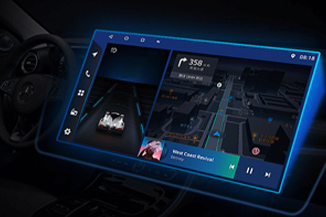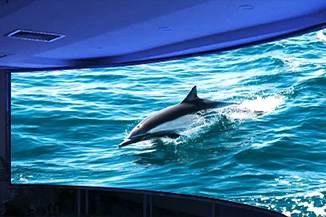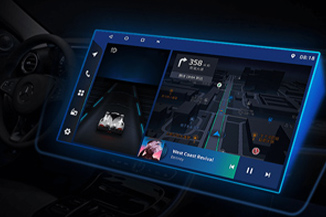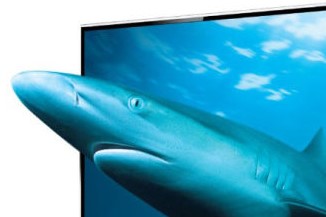Publisher: Supplier of LED Display Time: 2022-08-11 09:51 Views: 1668
Since the beginning of this year, under the influence of multiple factors, the price of mainstream panels has been falling all the way, and the entire industry has encountered a "cold winter". On topics such as when the industry will recover, which is of concern to the industry, Xie Qinyi, general manager of the display department of Omdia, a global communications, digital media and IT industry research organization, said in an exclusive interview with a reporter from the Shanghai Stock Exchange recently that the panel industry is expected to recover more moderately next year. Despite the current overall downturn in the industry, the growth momentum of VR/AR device displays, in-vehicle displays and public displays continues. In addition, in the long run, "integration" will be an important evolutionary trend for mobile phones and car screens.
Signs of recovery in the panel industry may appear next year
Affected by factors such as the sluggish demand for consumer electronics and the complex external environment, the panel market was significantly oversupplied in the first half of the year, and the prices of mainstream panels continued to bottom out, and some even fell below the cash cost. Reducing production capacity is a major move taken by panel makers.
"In July, the capacity utilization rate of manufacturers was adjusted to 69%, a record low in ten years. Although there will be a recovery in August and September, it will remain below 80%." Xie Qinyi said that the capital expenditure of the panel industry is very high, and the production capacity is very high. It is very uneconomical to have a processing rate below 80%, but as panel manufacturers are making more and more losses, they can only reduce production and control losses.
Recently, the latest research and statistics from several institutions show that the current market is still in a downward trend. TrendForce's research shows that in early August, in addition to 32-inch TV panels, the prices of other panels including TVs of various sizes, desktop monitors and notebooks all showed a downward trend. In terms of mobile phones, according to the latest statistics from market analysis agency CINNO Research, the global market shipments of AMOLED smartphone panels in the first half of 2022 are about 278 million, down 10.5% from the same period last year, and demand growth has slowed.
Xie Qinyi predicted that the oversupply situation will continue until the end of the year, and signs of recovery may appear next year. But he also said, "Next year's recovery will not be strong because end demand is not yet very strong, and the recovery stems from low prices to stimulate end market rebound. It is not expected that pure replacement demand will emerge until 2024, driving strong growth."

VR/AR and in-vehicle displays are still growing strongly
Although there is still a difficult period for the entire industry before the recovery, Xie Qinyi said that in the environment of poor display panel prosperity, there are still three application-side panel markets showing growth.
One is VR/AR device display. Therefore, this type of equipment has very high requirements on the resolution and frequency of the panel. At present, this market is still in the hands of Korean and other ground panel manufacturers.
"The display screen in a VR/AR device can only simulate the real thing with super high resolution, otherwise it will look fake. Second, the frequency needs to be very fast, if the screen refresh rate lags behind the eye movement, there will be eye turning. On the left, the screen still stays on the right with a visual gap, which will cause the user to feel dizzy and vomit." Xie Qinyi said.
The second is the vehicle display. The strong growth of electric vehicles requires in-vehicle screens of larger size and better performance, and the panel industry that does area business has significant opportunities to benefit.
"In terms of size, compared with traditional cars, the amount of information carried on the screen of electric cars is larger, and the car screen generally reaches more than 10 inches; in terms of performance, in addition to better picture quality, power saving is the most important performance of electric car displays. "Xie Qinyi said.
Finally, there is the public display track. With the relaxation of epidemic control in Europe and the United States, people returning to public places, including shopping malls, outdoor display screens in public spaces such as shopping malls, will usher in a wave of upgrading. "For example, transparent displays that are applied to shopping malls to attract consumers' attention are a new growth track." Xie Qinyi said.
The integration trend of mobile phone and electric vehicle display panel
When it comes to the evolution trend of display panels, Xie Qinyi regards "integration" as an important development direction in the field of mobile phones and car screens.
He said that the integration of mobile phone screens means that more and more sensors will be integrated into the screen. Consumers can currently see "bangs" and chutes on the screen of their mobile phones, just because there are so many things that have to be buried under the panel. With the evolution of technology, technologies including fingerprint recognition and facial recognition will be integrated into the screen.
"The integration of mobile phone screens is the biggest opportunity for OLED. The LCD screen used in traditional mobile phone applications hinders the screen from taking on the function of 'eyes' due to the existence of the backlight. The OLED panel has the characteristics of self-illumination, and there is no obstacle to the backlight. Therefore, in the integration of new It has obvious advantages in the process of new sensors or new chip technology." Xie Qinyi said.
Currently, about 40% of mobile phone screens on the market are OLED screens. He predicts this will grow to around 45% to 50% in the next few years. Because of the cost advantage of LCD panels, it will still have a place in the low-end mobile phone market.
Xie Qinyi said that in addition to mobile phone panels, vehicle panels are also moving towards integration. The difference is that the direction of the latter integration is panels and systems.
The "vehicle computer" that controls the car to realize various functions in an electric vehicle is the ECU (Electronic Control Unit), and the computing brain of the ECU is the MCU (Micro Control Unit) chip as the core component. In the human-vehicle interaction, the large touch screen is the medium that implements most functions centrally, while the MCU chips are scattered.
"More and more car manufacturers and panel manufacturers are now seeking to integrate panels and MCUs. A screen with a chip in it can direct the car to realize various functions. For example, BOE Jingdian, the leader in vehicle display, is not only doing panels, but also Also integrate the system into the screen." Xie Qinyi said.









